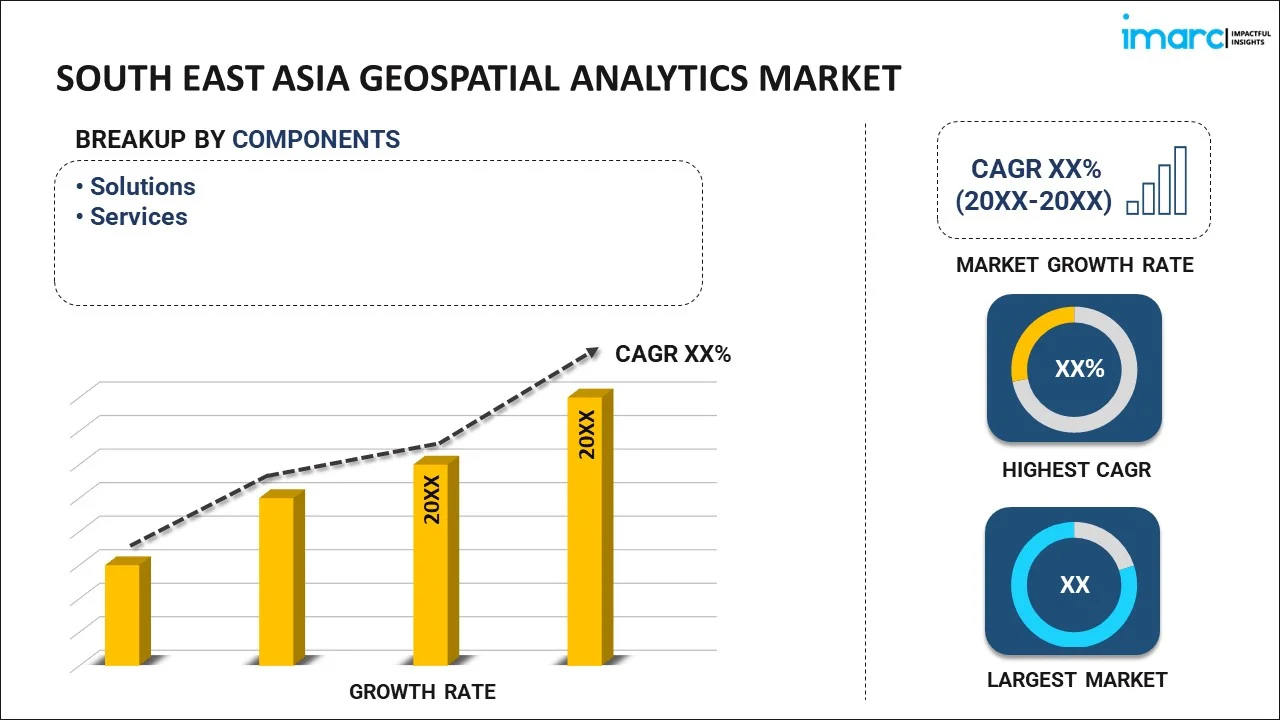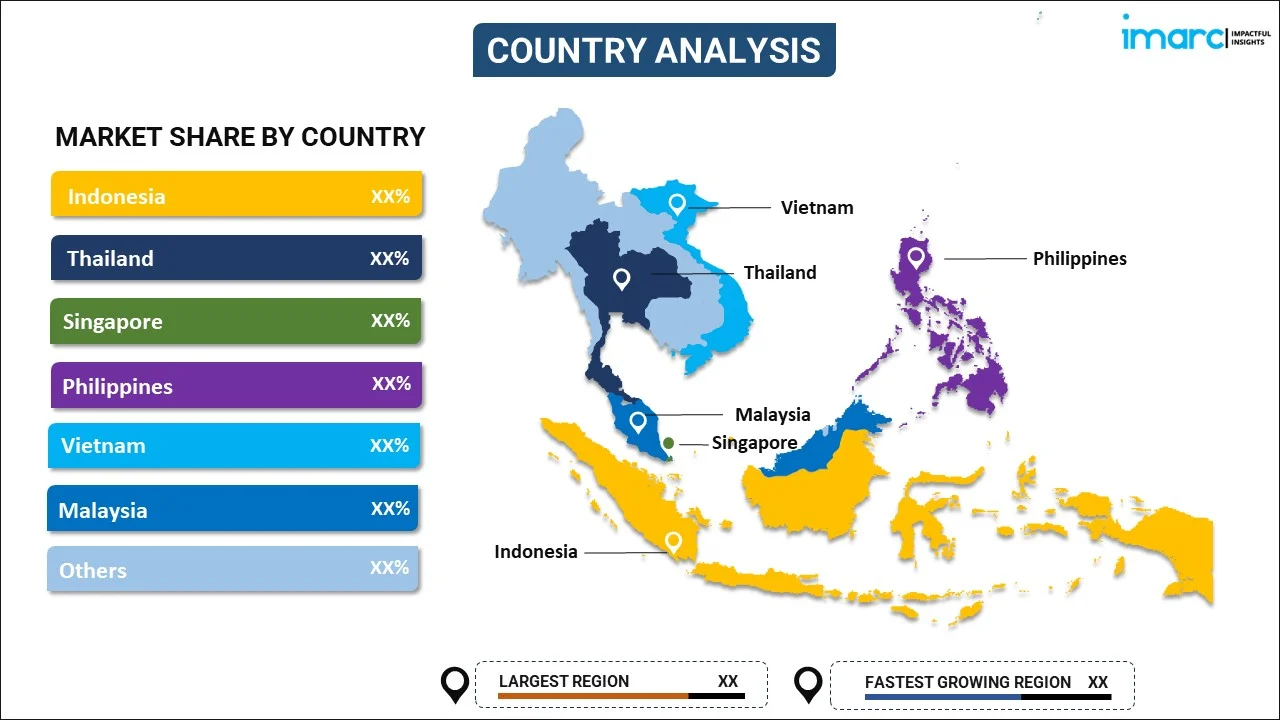
South East Asia Geospatial Analytics Market Report by Component (Solutions, Services), Type (Surface and Field Analytics, Network and Location Analytics, Geovisualization, and Others), Technology (Remote Sensing, GIS, GPS, and Others), Enterprise Size (Large Enterprises, Small and Medium-sized Enterprises), Deployment Mode (On-premises, Cloud-based), Vertical (Automotive, Energy and Utilities, Government, Defense and Intelligence, Smart Cities, Insurance, Natural Resources, and Others), and Country 2025-2033
Market Overview:
South East Asia geospatial analytics market size reached USD 4.3 Billion in 2024. Looking forward, IMARC Group expects the market to reach USD 11.7 Billion by 2033, exhibiting a growth rate (CAGR) of 11.79% during 2025-2033. The growing innovations in satellite imaging, unmanned aerial vehicles (UAVs), and sensor technologies, rising reliance on cloud computing, artificial intelligence (AI), and machine learning (ML), and increasing proliferation of location-based services (LBS) represent some of the key factors driving the market.
|
Report Attribute
|
Key Statistics
|
|---|---|
|
Base Year
|
2024
|
|
Forecast Years
|
2025-2033
|
|
Historical Years
|
2019-2024
|
|
Market Size in 2024
|
USD 4.3 Billion |
|
Market Forecast in 2033
|
USD 11.7 Billion |
| Market Growth Rate 2025-2033 | 11.79% |
Geospatial analytics is a data analysis approach that focuses on the geographic or spatial aspects of information. It comprises descriptive analytics, which involves summarizing and visualizing geographic data to gain an understanding of the current situation. It also consists of spatial analysis that can reveal clusters, trends, and spatial dependencies and focuses on the relationship and patterns of the spatial data. It includes predictive analytics, which uses historical data to forecast future events or trends in a specific geographic area. It involves the utilization of various technologies and techniques to capture, manage, analyze, and visualize geographic data. It empowers decision-makers with valuable insights, enabling them to make well-informed choices in urban planning, disaster management and other areas. It enables companies to optimize their operations, reduce costs, and improve resource allocation by leveraging location data. Geospatial analytics aids in monitoring and protecting natural ecosystems, contributing to sustainable environmental practices. It is crucial for responding to emergencies and ensuring the safety of communities. It streamlines processes and resource allocation, leading to increased operational efficiency. It also reduces guesswork and enhances the accuracy of decisions.
South East Asia Geospatial Analytics Market Trends:
At present, increasing innovations in satellite imaging, unmanned aerial vehicles (UAVs), and sensor technologies represent one of the crucial factors impelling the growth of the market in South East Asia. The advent of cloud computing, artificial intelligence (AI), and machine learning (ML) is significantly enhancing the processing power and analytical capabilities of geospatial tools. Cloud-based geospatial analytics platforms offer scalability, flexibility, and real-time data processing, empowering organizations to derive meaningful insights from massive and dynamic datasets. AI and ML algorithms, integrated into geospatial analytics solutions, enable predictive modeling, pattern recognition, and anomaly detection, unlocking new dimensions of decision support for businesses across various sectors. Besides this, the rising accessibility of high-resolution satellite imagery is contributing to the market growth in the region. Advances in satellite technology, coupled with initiatives from both public and private sectors, are leading to a significant reduction in the cost of acquiring and processing satellite imagery. This accessibility is also democratizing the use of geospatial data, enabling small and medium-sized enterprises (SMEs), as well as non-profit organizations, to harness the power of location intelligence. In addition, the growing proliferation of location-based services (LBS) is offering a favorable market outlook in the region. Businesses are leveraging geospatial analytics to enhance customer engagement through targeted marketing, location-based promotions, and optimized supply chain management. Apart from this, governing agencies in the region are recognizing the transformative potential of geospatial analytics and actively promoting its integration into public services and policy planning. They are also using geospatial analytics to address urbanization challenges, monitor natural resources, manage disaster response, and enhance overall public service delivery.
South East Asia Geospatial Analytics Market Segmentation:
IMARC Group provides an analysis of the key trends in each segment of the market, along with forecasts at the regional and country level for 2025-2033. Our report has categorized the market based on component, type, technology, enterprise size, deployment mode, and vertical.
Component Insights:

- Solutions
- Services
The report has provided a detailed breakup and analysis of the market based on the component. This includes solutions and services.
Type Insights:
- Surface and Field Analytics
- Network and Location Analytics
- Geovisualization
- Others
A detailed breakup and analysis of the market based on the type have also been provided in the report. This includes surface and field analytics, network and location analytics, geovisualization, and others.
Technology Insights:
- Remote Sensing
- GIS
- GPS
- Others
The report has provided a detailed breakup and analysis of the market based on the technology. This includes remote sensing, GIS, GPS, and others.
Enterprise Size Insights:
- Large Enterprises
- Small and Medium-sized Enterprises
A detailed breakup and analysis of the market based on enterprise size have also been provided in the report. This includes large enterprises and small and medium-sized enterprises.
Deployment Mode Insights:
- On-premises
- Cloud-based
The report has provided a detailed breakup and analysis of the market based on the deployment mode. This includes on-premises and cloud-based.
Vertical Insights:
- Automotive
- Energy and Utilities
- Government
- Defense and Intelligence
- Smart Cities
- Insurance
- Natural Resources
- Others
A detailed breakup and analysis of the market based on vertical have also been provided in the report. This includes automotive, energy and utilities, government, defense and intelligence, smart cities, insurance, natural resources, and others.
Country Insights:

- Indonesia
- Thailand
- Singapore
- Philippines
- Vietnam
- Malaysia
- Others
The report has also provided a comprehensive analysis of all the major regional markets, which include Indonesia, Thailand, Singapore, Philippines, Vietnam, Malaysia, and Others.
Competitive Landscape:
The market research report has also provided a comprehensive analysis of the competitive landscape. Competitive analysis such as market structure, key player positioning, top winning strategies, competitive dashboard, and company evaluation quadrant has been covered in the report. Also, detailed profiles of all major companies have been provided.
South East Asia Geospatial Analytics Market Report Coverage:
| Report Features | Details |
|---|---|
| Base Year of the Analysis | 2024 |
| Historical Period | 2019-2024 |
| Forecast Period | 2025-2033 |
| Units | Billion USD |
| Scope of the Report | Exploration of Historical and Forecast Trends, Industry Catalysts and Challenges, Segment-Wise Historical and Predictive Market Assessment:
|
| Components Covered | Solutions, Services |
| Types Covered | Surface and Field Analytics, Network and Location Analytics, Geovisualization, Others |
| Technologies Covered | Remote Sensing, GIS, GPS, Others |
| Enterprise Sizes Covered | Large Enterprises, Small and Medium-sized Enterprises |
| Deployment Modes Covered | On-premises, Cloud-based |
| Verticals Covered | Automotive, Energy and Utilities, Government, Defense and Intelligence, Smart Cities, Insurance, Natural Resources, Others |
| Countries Covered | Indonesia, Thailand, Singapore, Philippines, Vietnam, Malaysia, Others |
| Customization Scope | 10% Free Customization |
| Post-Sale Analyst Support | 10-12 Weeks |
| Delivery Format | PDF and Excel through Email (We can also provide the editable version of the report in PPT/Word format on special request) |
Key Questions Answered in This Report:
- How has the South East Asia geospatial analytics market performed so far and how will it perform in the coming years?
- What has been the impact of COVID-19 on the South East Asia geospatial analytics market?
- What is the breakup of the South East Asia geospatial analytics market on the basis of component?
- What is the breakup of the South East Asia geospatial analytics market on the basis of type?
- What is the breakup of the South East Asia geospatial analytics market on the basis of technology?
- What is the breakup of the South East Asia geospatial analytics market on the basis of enterprise size?
- What is the breakup of the South East Asia geospatial analytics market on the basis of deployment mode?
- What is the breakup of the South East Asia geospatial analytics market on the basis of vertical?
- What are the various stages in the value chain of the South East Asia geospatial analytics market?
- What are the key driving factors and challenges in South East Asia geospatial analytics?
- What is the structure of the South East Asia geospatial analytics market and who are the key players?
- What is the degree of competition in the South East Asia geospatial analytics market?
Key Benefits for Stakeholders:
- IMARC’s industry report offers a comprehensive quantitative analysis of various market segments, historical and current market trends, market forecasts, and dynamics of the South East Asia geospatial analytics market from 2019-2033.
- The research report provides the latest information on the market drivers, challenges, and opportunities in the South East Asia geospatial analytics market.
- Porter's five forces analysis assist stakeholders in assessing the impact of new entrants, competitive rivalry, supplier power, buyer power, and the threat of substitution. It helps stakeholders to analyze the level of competition within the South East Asia geospatial analytics industry and its attractiveness.
- A competitive landscape allows stakeholders to understand their competitive environment and provides an insight into the current positions of key players in the market.
Need more help?
- Speak to our experienced analysts for insights on the current market scenarios.
- Include additional segments and countries to customize the report as per your requirement.
- Gain an unparalleled competitive advantage in your domain by understanding how to utilize the report and positively impacting your operations and revenue.
- For further assistance, please connect with our analysts.
 Inquire Before Buying
Inquire Before Buying
 Speak to an Analyst
Speak to an Analyst
 Request Brochure
Request Brochure
 Request Customization
Request Customization




.webp)




.webp)












